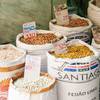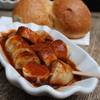כללי
תחבורה
אנשים
אירוח
אוכל ושתייה
 כמה עולה האוכל?
כמה עולה האוכל?
 אילו מקומות יש לאכול?
אילו מקומות יש לאכול?
 What local dishes to try in Germany?
What local dishes to try in Germany?
 מה ניתן לאכול בגרמניה בתור צמחוני?
מה ניתן לאכול בגרמניה בתור צמחוני?
 אם לכם שאלה כזו אפשר לשתות מים מהצנרת בגרמניה?
אם לכם שאלה כזו אפשר לשתות מים מהצנרת בגרמניה?
 אילו משקאות קרים זמינים?
אילו משקאות קרים זמינים?
 האם יש תרבות קפה ותה בגרמניה?
האם יש תרבות קפה ותה בגרמניה?
 איזה תערובות בירה לנסות בגרמניה?
איזה תערובות בירה לנסות בגרמניה?
 What other alcoholic drinks to try while in Germany?
What other alcoholic drinks to try while in Germany?
 מהם ההגבלות הקיימות לגבי צריבת אלכוהול?
מהם ההגבלות הקיימות לגבי צריבת אלכוהול?
 Where to buy alcohol in Germany and how much does it cost?
Where to buy alcohol in Germany and how much does it cost?
ביקור באתרים
משפטי
כסף
בטיחות ובריאות
נסיעות משפחתיות

What is the local food like in Germany?
German food is rich, hearty and diverse. It's comfort eating with high-quality, often locally sourced ingredients.
Traditional German cuisine fell out of fashion several decades ago, and was replaced by Italian and Mediterranean food, Asian food, and Middle Eastern food. But there's a growing movement to go back to those roots, and even high-class German chefs are rediscovering old classics, from sauerkraut to Sauerbraten (traditional German pot roast). Traditional fruits and vegetables, from parsnips and pumpkins to black salsify, sunchoke, cabbage, yellow carrots, and little-known strawberry and apple varietals, are all making a comeback. That said, "German food" is a bit of a misnomer, as traditional cooking varies greatly from region to region. Look for the "typical" dish, wherever you are, to get the best sense of German cooking.
Generally speaking, regions in the south, like Baden-Württemberg and Bavaria, have held onto their culinary traditions more than states in the north. But with a little effort, you can find good German food just about anywhere you go.
The cuisine of Germany has been shaped not only by the country's agricultural traditions but by the many immigrants that have made the country home over the centuries. It's definitely more than a mere mix of beer, sauerkraut and sausage.
Today Germans appreciate well-prepared, well-served meals as much as they do a quick bite on the go. Germany is a country of food markets, beer gardens, wine festivals, food museums and high-end restaurants.

איפה אני יכול להחליף מטבע?

מה ניתן להביא מגרמניה הביתה?

אם לכם שאלה כזו אפשר לשתות מים מהצנרת בגרמניה?

איך עובד תחבורה ציבורית בברלין?

האם זה קל לקבל עזרה רפואית בגרמניה?
